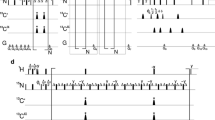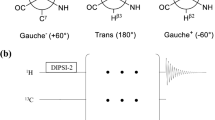Summary
Human ubiquitin is a 76-residue protein that serves as a protein degradation signal when conjugated to another protein. Ubiquitin has been shown to exist in at least three states: native (N-state), unfolded (U-state), and, when dissolved in 60% methanol:40% water at pH 2.0, partially folded (A-state). If the A-state represents an intermediate in the folding pathway of ubiquitin, comparison of the known structure of the N-state with that of the A-state may lead to an understanding of the folding pathway. Insights into the structural basis for ubiquitin's role in protein degradation may also be obtained. To this end we determined the secondary structure of the A-state using heteronuclear three-dimensional NMR spectroscopy of uniformly 15N-enriched ubiquitin. Sequence-specific 1H and 15N resonance assignments were made for more than 90% of the residues in the A-state. The assignments were made by concerted analysis of three-dimensional 1H-15N NOESY-HMQC and TOCSY-HMQC data sets. Because of 1H chemical shift degeneracies, the increased resolution provided by the 15N dimension was critical. Analysis of short- and long-range NOEs indicated that only the first two strands of β-sheet, comprising residues 2–17, remain in the A-state, compared to five strands in the N-state. NOEs indicative of an α-helix, comprising residues 25–33, were also identified. These residues were also helical in the N-state. In the N-state, residues in this helix were in contact with residues from the first two strands of β-sheet. It is likely, therefore, that residues 1–33 comprise a folded domain in the A-state of ubiquitin. On the basis of 1Hα chemical shifts and weak short-range NOEs, residues 34–76 do not adopt a rigid secondary structure but favor a helical conformation. This observation may be related to the helix-inducing effects of the methanol present. The secondary structure presented here differs from and is more thorough than that determined previously by two-dimensional 1H methods [Harding et al. (1991) Biochemistry, 30, 3120–3128].
Similar content being viewed by others
References
Bodenhausen, G. and Ruben, D.L. (1980) Chem. Phys. Lett., 69, 185–188.
Brown, S.C., Weber, P.L. and Mueller, L. (1988) J. Magn. Reson., 77, 166–169.
Di Stefano, D.L. and Wand, A.J. (1987) Biochemistry, 26, 7272–7281.
Harding, M.M., Williams, D.H. and Woolfson, D.N. (1991) Biochemistry, 30, 3120–3128.
Hershko, A. (1988) J. Biol. Chem., 263, 15237–15240.
Marion, D. and Wüthrich, K. (1983) Biochem. Biophys. Res. Commun., 113, 967–974.
Marion, D., Driscoll, P.C., Kay, L.E., Wingfield, P.T., Bax, A., Gronenborn, A.M. and Glore, G.M. (1989) Biochemistry, 28, 6150–6156.
Neri, D., Wider, G. and Wüthrich, K. (1992) Proc. Natl. Acad. Sci. USA, 89, 4397–4401.
Pan, Y. and Briggs, M.S. (1992) Biochemistry, 31, 11405–11412.
Schneider, D.M., Dellwo, M.J. and Wand, A.J. (1992) Biochemistry, 31, 3645–3652.
Shaka, A.J., Barker, P.B. and Freeman, R. (1985) J. Magn. Reson., 64, 547–552.
Shaka, A.J., Lee, C.J. and Pines, A. (1988) J. Magn. Reson., 77, 274–293.
States, D.J., Haberkorn, R.A. and Ruben, D.J. (1982) J. Magn. Reson., 48, 286–292.
Vijay-Kumar, S., Bugg, C.E. and Cook, W.J. (1987) J. Mol. Biol., 194, 531–544.
Weber, P.L., Brown, S.C. and Mueller, L. (1987) Biochemistry, 26, 7282–7290.
Wishart, D.S., Sykes, B.D. and Richards, F.M. (1991) J. Mol. Biol., 222, 311–333.
Wishart, D.S., Sykes, B.D. and Richards, F.M. (1992) Biochemistry, 31, 1647–1651.
Wüthrich, K. (1986) NMR of Proteins and Nucleic Acids, Wiley, New York.
Zuiderweg, E.R.P. and Fesik, S.W. (1989) Biochemistry, 28, 2387–2391.
Author information
Authors and Affiliations
Rights and permissions
About this article
Cite this article
Stockman, B.J., Euvrard, A. & Scahill, T.A. Heteronuclear three-dimensional NMR spectroscopy of a partially denatured protein: The A-state of human ubiquitin. J Biomol NMR 3, 285–296 (1993). https://doi.org/10.1007/BF00212515
Received:
Accepted:
Issue Date:
DOI: https://doi.org/10.1007/BF00212515




